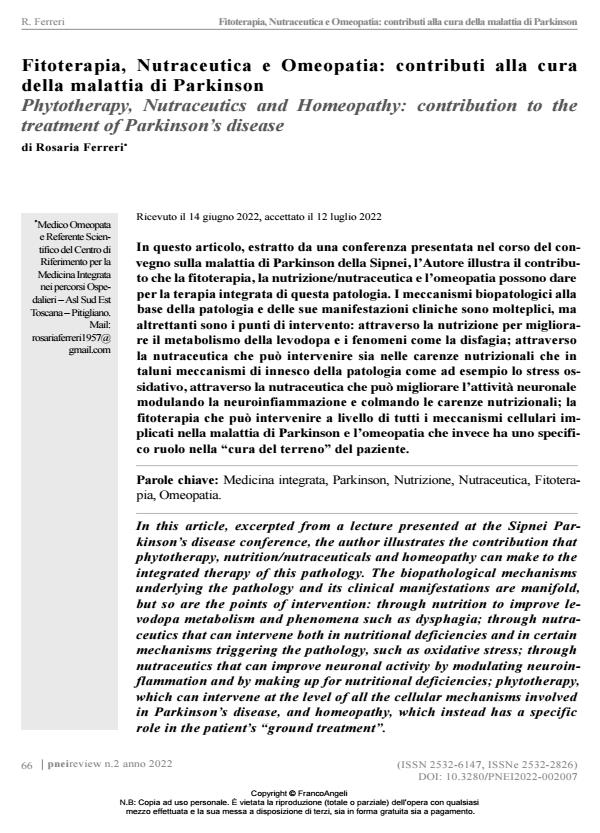Phytotherapy, Nutraceutics and Homeopathy: contribution to the treatment of Parkinson’s disease
Journal title PNEI REVIEW
Author/s Rosaria Ferreri
Publishing Year 2022 Issue 2022/2
Language Italian Pages 8 P. 66-73 File size 89 KB
DOI 10.3280/PNEI2022-002007
DOI is like a bar code for intellectual property: to have more infomation
click here
Below, you can see the article first page
If you want to buy this article in PDF format, you can do it, following the instructions to buy download credits

FrancoAngeli is member of Publishers International Linking Association, Inc (PILA), a not-for-profit association which run the CrossRef service enabling links to and from online scholarly content.
In this article, excerpted from a lecture presented at the Sipnei Parkinson’s disease conference, the author illustrates the contribution that phytotherapy, nutrition/nutraceuticals and homeopathy can make to the integrated therapy of this pathology. The biopathological mechanisms underlying the pathology and its clinical manifestations are manifold, but so are the points of intervention: through nutrition to improve le- vodopa metabolism and phenomena such as dysphagia; through nutra- ceutics that can intervene both in nutritional deficiencies and in certain mechanisms triggering the pathology, such as oxidative stress; through nutraceutics that can improve neuronal activity by modulating neuroin- flammation and by making up for nutritional deficiencies; phytotherapy, which can intervene at the level of all the cellular mechanisms involved in Parkinson’s disease, and homeopathy, which instead has a specific role in the patient’s "ground treatment".
Keywords: Integrative medicine, Parkinson, Nutrition, Nutraceutics, Phytotherapy, Homeopathy.
- Belayev L., Mukherjee P.K., Balaszczuk V., Calandria J.M., Obenaus A., Khoutorova L., Hong S.-H., & Bazan N.G. (2017). Neuroprotectin D1 upre- gulates Iduna expression and provides protection in cellular uncompensated oxidative stress and in experimental ischemic stroke. Cell Death & Differen- tiation, 24(6), 1091–1099.
- Cacabelos R. (2017). Parkinson’s Disease: From Pathogenesis to Pharmaco- genomics. International Journal of Molecular Sciences, 18(3), 551.
- Cox P.A., & Metcalf J.S. (2017). Traditional Food Items in Ogimi, Okinawa: l-Serine Content and the Potential for Neuroprotection. Current Nutrition Re- ports, 6(1), 24–31.
- García-Cáceres C., Quarta C., Varela L., Gao Y., Gruber T., Legutko B., Jastroch M., Johansson P., Ninkovic J., Yi C.-X., Le Thuc O., Szigeti-Buck K., Cai W., Meyer C.W., Pfluger P.T., Fernandez A.M., Luquet S., Wo- ods S.C., Torres-Alemán I., Kahn C.R., Götz M., Horvath T.L., & Tschöp M.H. (2016). Astrocytic Insulin Signaling Couples Brain Glucose Uptake with Nutrient Availability. Cell, 166(4), 867–880.
- Goya M.E., Xue F., Sampedro-Torres-Quevedo C., Arnaouteli S., Riquel- me-Dominguez L., Romanowski A., Brydon J., Ball K.L., Stanley-Wall N.R., & Doitsidou M. (2020). Probiotic Bacillus subtilis Protects against α-Synuclein Aggregation in C. elegans. Cell Reports, 30(2), 367-380.e7.
- Jiang G., Hu Y., Liu L., Cai J., Peng C., & Li Q. (2014). Gastrodin pro- tects against MPP+-induced oxidative stress by up regulates heme oxygena- se-1 expression through p38 MAPK/Nrf2 pathway in human dopaminergic cel- ls. Neurochemistry International, 75, 79–88.
- Jiang T., Chu J., Chen H., Cheng H., Su J., Wang X., Cao Y., Tian S., & Li Q. (2020). Gastrodin Inhibits H2O2-Induced Ferroptosis through Its An- tioxidative Effect in Rat Glioma Cell Line C6. Biological and Pharmaceutical Bulletin, 43(3), 480–487.
- Kubota M., Kobayashi N., Sugizaki T., Shimoda M., Kawahara M., & Ta- naka K. (2020). Carnosine suppresses neuronal cell death and inflammation induced by 6-hydroxydopamine in an in vitro model of Parkinson’s disease. PLOS ONE, 15(10), e0240448.
- Liu C.-Y., Lee C.-F., & Wei Y.-H. (2009). Role of Reactive Oxygen Species-eli-cited Apoptosis in the Pathophysiology of Mitochondrial and Neurodegenerative Diseases Associated With Mitochondrial DNA Mutations. Journal of the Formo- san Medical Association, 108(8), 599–611. DOI: 10.1016/S0929-6646(09)60380-
- McRae M.P. (2013). Betaine supplementation decreases plasma homocysteine in healthy adult participants: a meta-analysis. Journal of Chiropractic Medicine, 12(1), 20–25.
- Sagrario M.-A., Mp G., J B., & P B.-B. (2019). Plants with evidence-based thera- peutic effects against neurodegenerative diseases. Pharmacy & Pharmacology In- ternational Journal, 7(5), 221–227.
- Seidl S.E., Santiago J.A., Bilyk H., & Potashkin J.A. (2014). The emerging role of nutrition in Parkinson’s disease. Frontiers in Aging Neuroscience, 6, 36.
- Stafstrom C.E., & Rho J.M. (2012). The Ketogenic Diet as a Treatment Pa- radigm for Diverse Neurological Disorders. Frontiers in Pharmacology, 3, 59.
- Tansey M.G., & Goldberg M.S. (2010). Neuroinflammation in Parkinson’s dise- ase: Its role in neuronal death and implications for therapeutic intervention. Neu- robiology of Disease, 37(3), 510–518.
- Watanabe H., Ohta H., Imamura L., Asakura W., Matoba Y., & Matsumoto
- K. (1991). Effect of Panax Ginseng on Age-Related Changes in the Spontaneous Motor Activity and Dopaminergic Nervous System in the Rat. Japanese Journal of Pharmacology, 55(1), 51–56. DOI: 10.1016/S0021-5198(19)39977-9
- Yin R., Xue J., Tan Y., Fang C., Hu C., Yang Q., Mei X., & Qi D. (2021). The Positive Role and Mechanism of Herbal Medicine in Parkinson’s Dise- ase. Oxidative Medicine and Cellular Longevity, 2021, 1–23. DOI: 10.1155/2021/992333
Rosaria Ferreri, Fitoterapia, Nutraceutica e Omeopatia: contributi alla cura della malattia di Parkinson in "PNEI REVIEW" 2/2022, pp 66-73, DOI: 10.3280/PNEI2022-002007